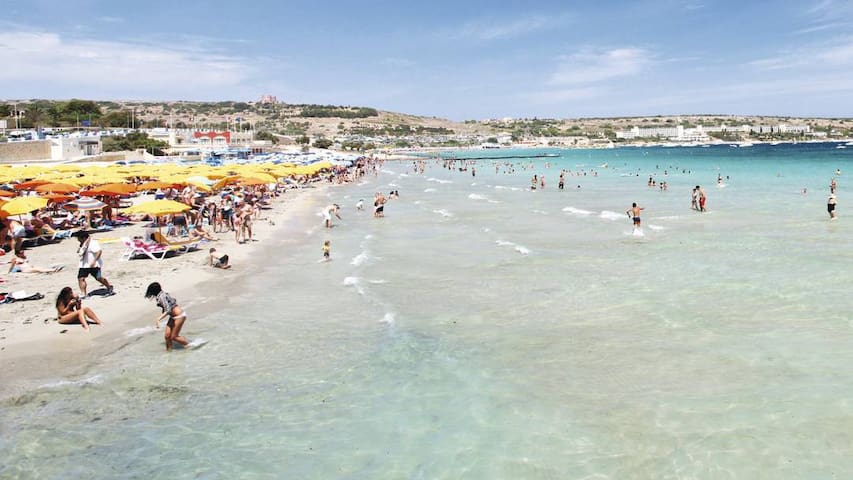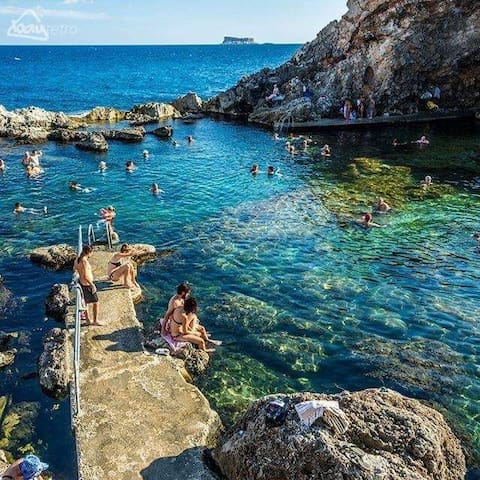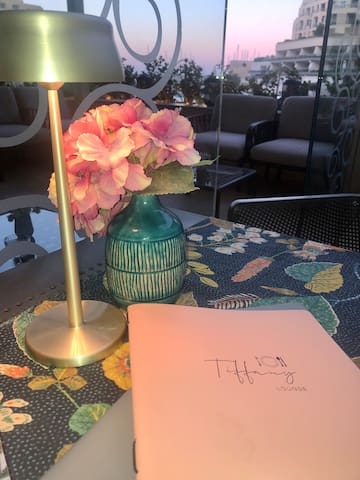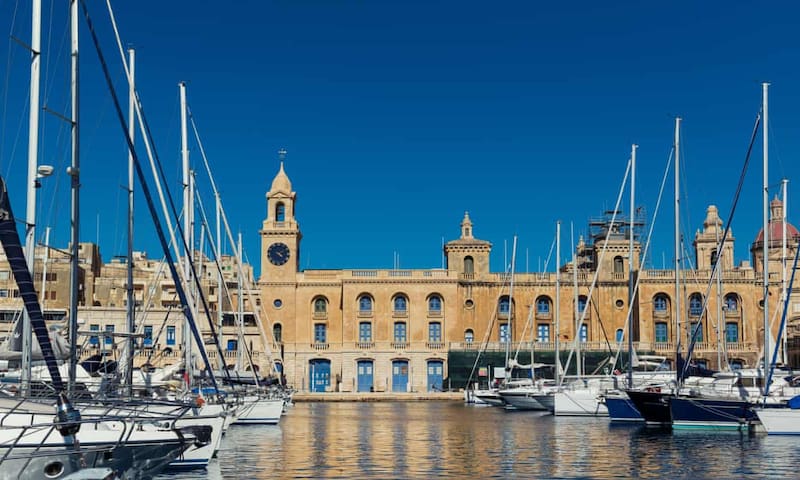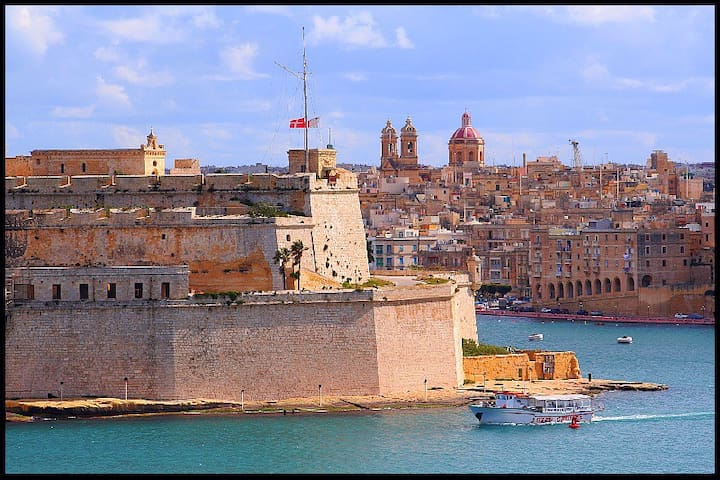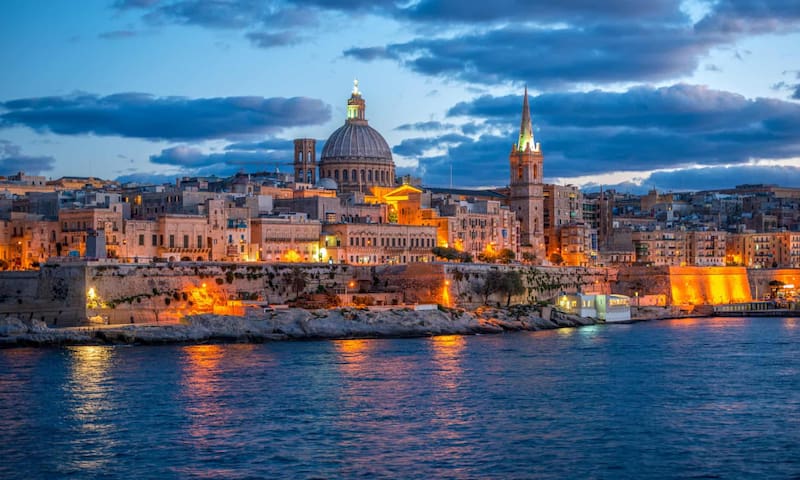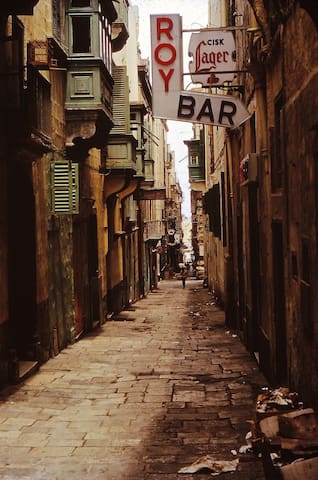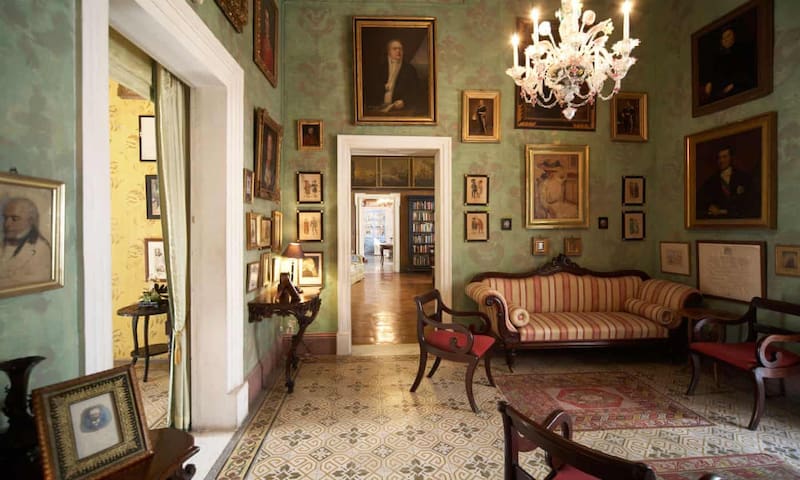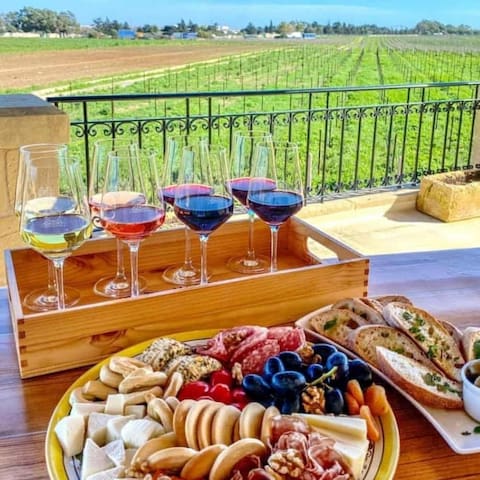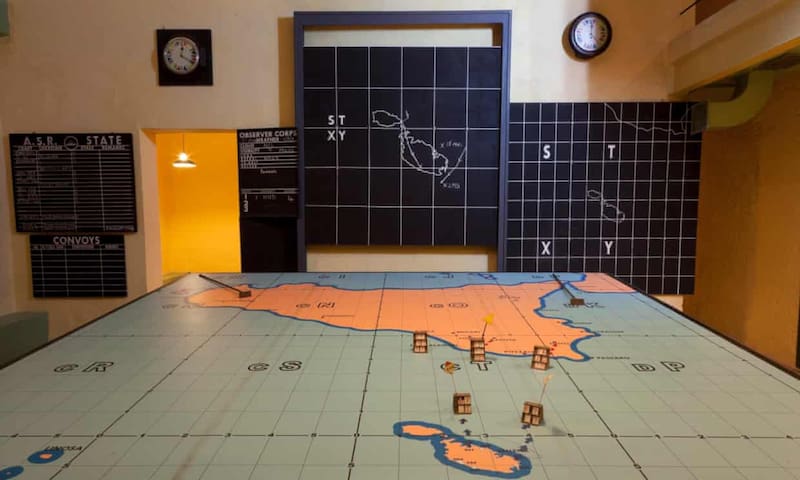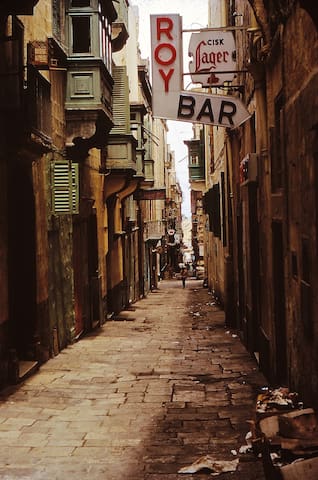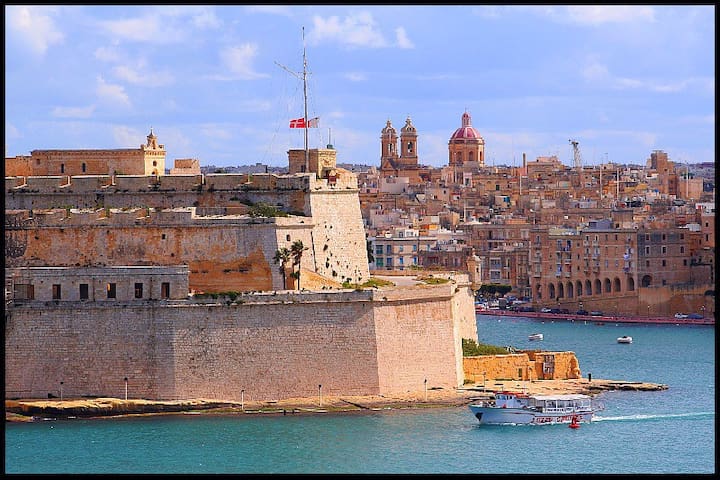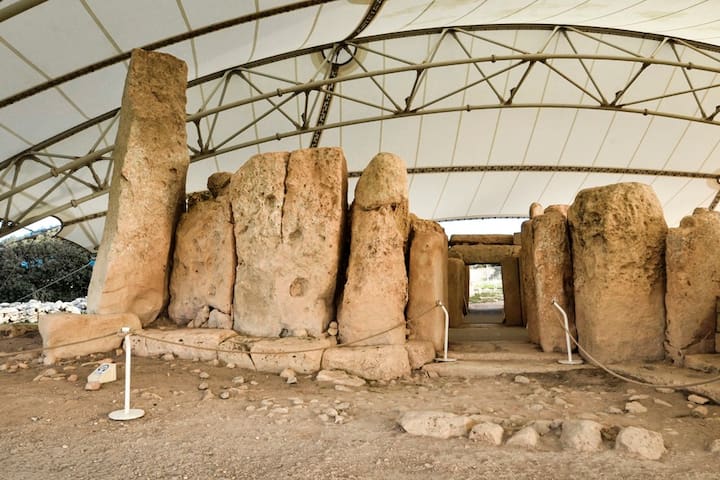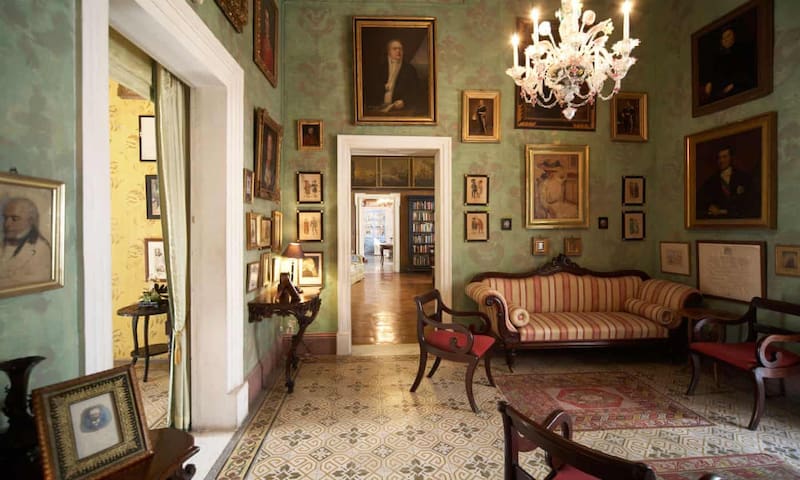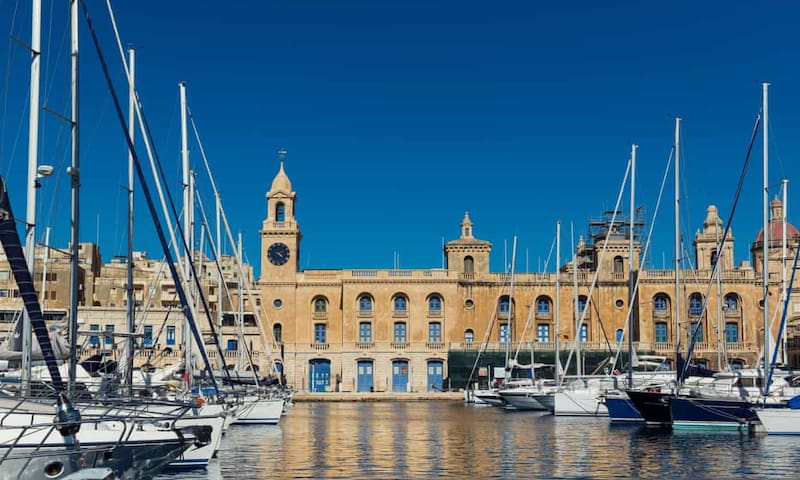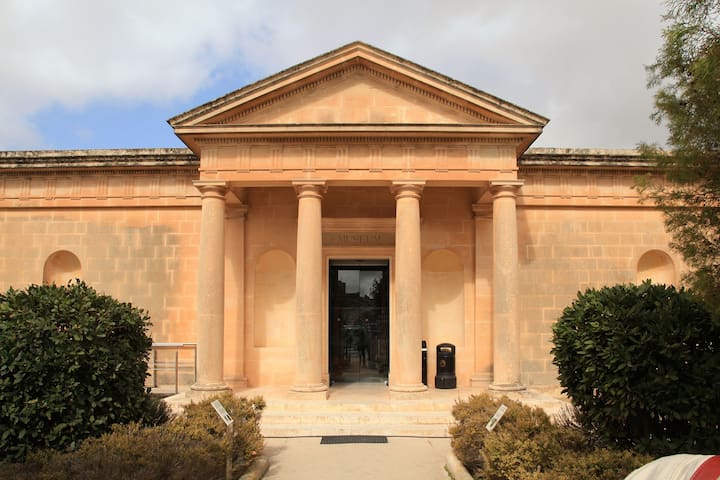Fun things to do in Malta
There is a hop on hop off boat going to Comino, the Blue Lagoon, and Gozo. This boat leaves from Sliema and Bugibba. You can also charter a private Yacht for a day or more, with a Skipper and food if you wish. I can arrange this for you. There is also the possibility of going on a day trip to Sicily leaving with the Catarmaran from Valletta.
This is where the hop on hop off boat departs to Comino, the Blue Lagoon as well as the ferry to Valletta.
113 lokal ang nagrerekomenda
Sliema Ferry station
Boat StreetThis is where the hop on hop off boat departs to Comino, the Blue Lagoon as well as the ferry to Valletta.
This is Malta's beautiful crystal clear sea in Comino. Worth a visit. You can either charter a private yacht and combine it with a chef on board, dive in Comino whilst the boat is anchored OR catch the hop on hop off boat. I can arrange it all for you.
122 lokal ang nagrerekomenda
Blue Lagoon
Triq KemmunetiThis is Malta's beautiful crystal clear sea in Comino. Worth a visit. You can either charter a private yacht and combine it with a chef on board, dive in Comino whilst the boat is anchored OR catch the hop on hop off boat. I can arrange it all for you.
Malta's sister island, Gozo. You can either go to Cirkewwa and catch the Gozo ferry. You can get there by car or by foot. The boat leaves about every 30 minutes - 1 hour. Alternatively, you can arrange a day trip to visit the island.
12 lokal ang nagrerekomenda
Gozo Ferry Terminal station
Triq Ix XattMalta's sister island, Gozo. You can either go to Cirkewwa and catch the Gozo ferry. You can get there by car or by foot. The boat leaves about every 30 minutes - 1 hour. Alternatively, you can arrange a day trip to visit the island.
Private Pool, lounge music, asian fusion cuisine. This is located in Sliema and open from mornings to evenings.
43 lokal ang nagrerekomenda
MedAsia Playa
Ix - Xatt Ta' Qui - Si - SanaPrivate Pool, lounge music, asian fusion cuisine. This is located in Sliema and open from mornings to evenings.
Located in Qawra, San Pawl il-Bahar, Cafe del Mar has a Private Pool area with lounge music in the evenings. Restaurant with Mediterranean cuisine. Tickets are around EUR 15 per person for a full day. The pool is 100m. Beautiful, breathtaking views of St Paul's Bay island and Gozo. Worth visiting during sunset too.
170 lokal ang nagrerekomenda
Cafe Del Mar Malta
Triq It - TruncieraLocated in Qawra, San Pawl il-Bahar, Cafe del Mar has a Private Pool area with lounge music in the evenings. Restaurant with Mediterranean cuisine. Tickets are around EUR 15 per person for a full day. The pool is 100m. Beautiful, breathtaking views of St Paul's Bay island and Gozo. Worth visiting during sunset too.
2 beautiful natural beaches surrounded by cliffs.
Golden Bay is located next to Għajn Tuffieħa on the northwest coast of Malta, nearby the villages of Mgarr and Manikata and is known for its red sand and naturally formed dunes on its surrounding slopes. Golden Bay is a popularly visited beach, partly due to the proximity of the five star Radisson Golden Sands hotel.
Golden Bay is a sandy beach and it tends to be more popular because it has a larger stretch of sand, is easier to access and has better facilities, including a few restaurants.
It’s very easy to reach by public transport and car, although parking can be a challenge on Sundays and public holidays. The beach is a popular location for sunbathing, swimming, watersports, and parties, especially in the evening when sunset admirers fire up their barbeques and enjoy a chilled out summer night at the beach.
During the summer months, a flag system is used to indicate whether the water is safe for swimming and lifeguards are on patrol. Just as is the case at Għajn Tuffieħa, Golden Bay is also known for its treacherous undercurrents during the winter months when the weather is less stable. Although few people would consider going for a swim during that time of the year, it’s not uncommon for a few adventurous (mostly foreign) people to get into trouble that way.
Lifeguards are on duty during the summer months, operated by the Malta Tourism Authority from 15th June until 15th September.
Golden Bay is located on the West coast and is one of Malta's best beaches.
46 lokal ang nagrerekomenda
Golden Bay Beach
2 beautiful natural beaches surrounded by cliffs.
Golden Bay is located next to Għajn Tuffieħa on the northwest coast of Malta, nearby the villages of Mgarr and Manikata and is known for its red sand and naturally formed dunes on its surrounding slopes. Golden Bay is a popularly visited beach, partly due to the proximity of the five star Radisson Golden Sands hotel.
Golden Bay is a sandy beach and it tends to be more popular because it has a larger stretch of sand, is easier to access and has better facilities, including a few restaurants.
It’s very easy to reach by public transport and car, although parking can be a challenge on Sundays and public holidays. The beach is a popular location for sunbathing, swimming, watersports, and parties, especially in the evening when sunset admirers fire up their barbeques and enjoy a chilled out summer night at the beach.
During the summer months, a flag system is used to indicate whether the water is safe for swimming and lifeguards are on patrol. Just as is the case at Għajn Tuffieħa, Golden Bay is also known for its treacherous undercurrents during the winter months when the weather is less stable. Although few people would consider going for a swim during that time of the year, it’s not uncommon for a few adventurous (mostly foreign) people to get into trouble that way.
Lifeguards are on duty during the summer months, operated by the Malta Tourism Authority from 15th June until 15th September.
Golden Bay is located on the West coast and is one of Malta's best beaches.
Malta's longest beach with beautiful clear waters.
Mellieha Bay, also known as Ghadira Bay, is the largest and one of the most beautiful and popular sandy beach in Malta located in the northern part of the Island, just off the town of Mellieha. The shallow water that is ankle deep for about 50 metres out to sea and easy accessibility is makes the beach one of the most family friendly beaches in Malta. Mellieha Bay has endless activities to choose from like windsurfing, kite surfing, canoeing, water-skiing, and even a blow up water platform for the children out in the sea, something to keep bathers happy for hours. Even though Mellieha Bay is the most popular sandy beach in Malta, it is large enough not to be crowded except during weekends in the peak summer months. Mellieha Bay is in fact divided into three beaches separated by short rocky sections and one can choose from staying on the calmer side or on the more lively and active part. The middle beach is the widest and longest stretch of sand with all the activities and the most popular one. The last bay on the right hand side offers a quieter and more relaxing atmosphere for the more easy going bathers. Mellieha Bay does not have any underwater currents and hardly ever experiences rough seas, making the Bay ideal and safe for children.
77 lokal ang nagrerekomenda
Mellieha Bay
Malta's longest beach with beautiful clear waters.
Mellieha Bay, also known as Ghadira Bay, is the largest and one of the most beautiful and popular sandy beach in Malta located in the northern part of the Island, just off the town of Mellieha. The shallow water that is ankle deep for about 50 metres out to sea and easy accessibility is makes the beach one of the most family friendly beaches in Malta. Mellieha Bay has endless activities to choose from like windsurfing, kite surfing, canoeing, water-skiing, and even a blow up water platform for the children out in the sea, something to keep bathers happy for hours. Even though Mellieha Bay is the most popular sandy beach in Malta, it is large enough not to be crowded except during weekends in the peak summer months. Mellieha Bay is in fact divided into three beaches separated by short rocky sections and one can choose from staying on the calmer side or on the more lively and active part. The middle beach is the widest and longest stretch of sand with all the activities and the most popular one. The last bay on the right hand side offers a quieter and more relaxing atmosphere for the more easy going bathers. Mellieha Bay does not have any underwater currents and hardly ever experiences rough seas, making the Bay ideal and safe for children.
Malta's science Museum ideal for everybody. Open every day
34 lokal ang nagrerekomenda
Esplora station
Malta's science Museum ideal for everybody. Open every day
Malta's capital City is worth a visit. There's the St John's cathedral with the original painting of Caravaggio; the beheading of St. John. There are nice cafeteria's and small restaurants and a few small shops and boutiques. You can walk through the narrow streets of Valletta and visit some art museums or old theatre, the Manoel theatre.
594 lokal ang nagrerekomenda
Valletta
Malta's capital City is worth a visit. There's the St John's cathedral with the original painting of Caravaggio; the beheading of St. John. There are nice cafeteria's and small restaurants and a few small shops and boutiques. You can walk through the narrow streets of Valletta and visit some art museums or old theatre, the Manoel theatre.
Malta's old capital city; the silent City. Very narrow streets and car free. Worth combining with a visit to Rabat, the Roman baths
472 lokal ang nagrerekomenda
Mdina
Malta's old capital city; the silent City. Very narrow streets and car free. Worth combining with a visit to Rabat, the Roman baths
Malta's bar and club area. Lots of restaurants, dancing bars and clubs. There is a small beach called St George's Bay, Malta's largest Cinema theatres, Bowling alley, Baystreet Shopping & Entertainment arcade, most of Malta's hotels are located here too.
367 lokal ang nagrerekomenda
Paceville
Malta's bar and club area. Lots of restaurants, dancing bars and clubs. There is a small beach called St George's Bay, Malta's largest Cinema theatres, Bowling alley, Baystreet Shopping & Entertainment arcade, most of Malta's hotels are located here too.
This gives you the opportunity of seeing Malta at your own leisure and stopping by places of interest or beaches for an hour or longer then hopping onto the bus when you think fit. Website https://city-sightseeing.com/en/65/malta?utm_source=google&utm_medium=cpc&utm_campaign=malta_en&utm_term=hop%20on%20hop%20off%20malta&utm_content=Malta&gclid=Cj0KCQjw5-WRBhCKARIsAAId9FmgkE5v_HwSllUWm34yo7bVwZdgenJLPQkZQ6qFyHDG_YXr2m2v798aAglDEALw_wcB
23 lokal ang nagrerekomenda
Malta Sightseeing hop on hop off South tour
This gives you the opportunity of seeing Malta at your own leisure and stopping by places of interest or beaches for an hour or longer then hopping onto the bus when you think fit. Website https://city-sightseeing.com/en/65/malta?utm_source=google&utm_medium=cpc&utm_campaign=malta_en&utm_term=hop%20on%20hop%20off%20malta&utm_content=Malta&gclid=Cj0KCQjw5-WRBhCKARIsAAId9FmgkE5v_HwSllUWm34yo7bVwZdgenJLPQkZQ6qFyHDG_YXr2m2v798aAglDEALw_wcB
Mediterraneo Marine Park
Ambience, cuisine, decor, views make this place a superb place in Malta. Has a jetty so you can anchor your yacht whilst enjoying your day at Beefbar.
12 lokal ang nagrerekomenda
Beefbar on the beach
Dawret Il-GzejjerAmbience, cuisine, decor, views make this place a superb place in Malta. Has a jetty so you can anchor your yacht whilst enjoying your day at Beefbar.
In Malta you’re surrounded by limestone, from the old cities of Mdina and Valletta, through the megalithic temples of Hagar Qim, Mnajdra and the Hypogeum, to the ornaments on the traditional Maltese townhouses. The limestone has been instrumental in preserving the history of the island. At the family-run Limestone Heritage Park and Gardens, in Siggiewi village, visitors can trace the use and role of this resource throughout the ages. Don’t miss the stone-carving and sculpting, where a visitor can spend time working on a limestone souvenir. The Farmer’s Lunch, in the peaceful garden of the estate, is a great way to try Maltese gbejna cheese, homemade pasta and rabbit dishes and traditional desserts. Younger visitors will enjoy the heritage park: there’s space to run around in, and an animal petting zoo.
€8.10 adult, €5.40 student, €2.70 child with online discount, www.limestoneheritage.com
16 lokal ang nagrerekomenda
Ang Limestone Heritage Park at Mga Hardin
Triq Mons Mikel azzopardiIn Malta you’re surrounded by limestone, from the old cities of Mdina and Valletta, through the megalithic temples of Hagar Qim, Mnajdra and the Hypogeum, to the ornaments on the traditional Maltese townhouses. The limestone has been instrumental in preserving the history of the island. At the family-run Limestone Heritage Park and Gardens, in Siggiewi village, visitors can trace the use and role of this resource throughout the ages. Don’t miss the stone-carving and sculpting, where a visitor can spend time working on a limestone souvenir. The Farmer’s Lunch, in the peaceful garden of the estate, is a great way to try Maltese gbejna cheese, homemade pasta and rabbit dishes and traditional desserts. Younger visitors will enjoy the heritage park: there’s space to run around in, and an animal petting zoo.
€8.10 adult, €5.40 student, €2.70 child with online discount, www.limestoneheritage.com
Ghar Lapsi is a small fishing place with just three restaurants known for their fresh fish. The place is worth a visit because one has very lovely views to admire and the sea is marvellous.
It is very picturesque and snorkelling is fantastic here. Beach/swim shoes are a must you would regret bare feet as the rocks are sharp in places. If you locate yourself in the cave you will also be sheltered from the sun for much of the day should you wish. Parking at the top is free and its a three minute walk down to the sea.
37 lokal ang nagrerekomenda
Ghar Lapsi
Ghar Lapsi is a small fishing place with just three restaurants known for their fresh fish. The place is worth a visit because one has very lovely views to admire and the sea is marvellous.
It is very picturesque and snorkelling is fantastic here. Beach/swim shoes are a must you would regret bare feet as the rocks are sharp in places. If you locate yourself in the cave you will also be sheltered from the sun for much of the day should you wish. Parking at the top is free and its a three minute walk down to the sea.
Food scene
Fine dining with a great selection of wines, excellent service and ambience. Located at Portomaso, St. Julians
Website: https://tiffany.mt
7 lokal ang nagrerekomenda
Tiffany
Fine dining with a great selection of wines, excellent service and ambience. Located at Portomaso, St. Julians
Website: https://tiffany.mt
This museum gives visitors the opportunity to dine inside the museum itself. The atmosphere is special, the menu exquisite, and unique – as historians and chefs have researched 18th-century documents to find foreign influences, ingredients, spices and eating habits from the menus used by the knights. The Maltese fruit and vegetables used are grown by local farmers, the sausages are made by the butcher round the corner strictly following traditional methods and the in-house chefs follow the authentic recipes. This is a dining experience like no other. The building is a former bakery from the British period in Birgu, one of the three cities just across the Grand Harbour from Valletta.
Maritime museum, www.heritagemalta.org.
34 lokal ang nagrerekomenda
Malta Maritime Museum
Il - Habs L - AntikThis museum gives visitors the opportunity to dine inside the museum itself. The atmosphere is special, the menu exquisite, and unique – as historians and chefs have researched 18th-century documents to find foreign influences, ingredients, spices and eating habits from the menus used by the knights. The Maltese fruit and vegetables used are grown by local farmers, the sausages are made by the butcher round the corner strictly following traditional methods and the in-house chefs follow the authentic recipes. This is a dining experience like no other. The building is a former bakery from the British period in Birgu, one of the three cities just across the Grand Harbour from Valletta.
Maritime museum, www.heritagemalta.org.
Beautiful location, decor, and dining at Hammett's is a wonderful experience. Located in l-Isla.
Website: https://www.cugogranmalta.com
Cugó Gran Macina Grand Harbour
Beautiful location, decor, and dining at Hammett's is a wonderful experience. Located in l-Isla.
Website: https://www.cugogranmalta.com
Excellent cuisine, cocktails, fine wine selection, Hammett’s Mestizo is a vibrant Meso-South American inspired fusion social dining and drinking experience, with culinary influences expanding from Central America to the Caribbean and from the Andes to Amazon and Patagonia.
Located in Paceville, St. Julians
https://www.hammettsmestizo.com
Hammett's Mestizo
Excellent cuisine, cocktails, fine wine selection, Hammett’s Mestizo is a vibrant Meso-South American inspired fusion social dining and drinking experience, with culinary influences expanding from Central America to the Caribbean and from the Andes to Amazon and Patagonia.
Located in Paceville, St. Julians
https://www.hammettsmestizo.com
Decorated with huts, waterfalls and lush greenery, the Blue Elephant restaurant in Malta is reminiscent of a traditional Thai Village, showcasing the vibrant colors, exotic flavors and extravagant presentation of Thai cuisine. Part of a world-wide network of opulent restaurants, the Blue Elephant is highly recommended and never fails to both surprise and accomplish its promise to transport you to the lands of the East… in style!
Located at Portomaso, St. Julians
Website: https://www.blueelephant.com
19 lokal ang nagrerekomenda
Blue Elephant
Decorated with huts, waterfalls and lush greenery, the Blue Elephant restaurant in Malta is reminiscent of a traditional Thai Village, showcasing the vibrant colors, exotic flavors and extravagant presentation of Thai cuisine. Part of a world-wide network of opulent restaurants, the Blue Elephant is highly recommended and never fails to both surprise and accomplish its promise to transport you to the lands of the East… in style!
Located at Portomaso, St. Julians
Website: https://www.blueelephant.com
Japanese restaurant located at Portomaso in St. Julians
Website: https://www.themarinarestaurants.com/restaurants/zen
15 lokal ang nagrerekomenda
Zen Japanese Sushi Bar & Teppanyaki
Japanese restaurant located at Portomaso in St. Julians
Website: https://www.themarinarestaurants.com/restaurants/zen
City/town information
Phoenicians, Greeks, Romans, Byzantines, Arabs, Normans, the Angevines, the Aragonese and the Order of Saint John all contributed to the development of Birgu.
After being driven out of Rhodes by the Ottoman Empire, the Order of Saint John were granted Malta as their new home. The city was fortified in the 1530s and strengthened in the 1550s in preparation for an attack by the Ottoman Empire.
Birgu was the site of major battles between the Knights and the Ottoman Empire during the Great Siege of Malta in 1565. After four months of successful defence by the Knights, the city was almost captured by the Ottoman army in August, but was recaptured by the Knights under Grand Master Jean Parisot de Valette.
In 1571, the Knights transferred their convent and seat to the new capital and Birgu lost some of its importance.
After the taking of Malta by Napoleon in 1798, French forces were garrisoned in the city. Soon after, the Maltese rebelled and the Grand Harbour area was blockaded by Maltese rebels aided by Britain, Portugal and Naples. The French eventually capitulated in September 1800, and Malta became a British protectorate. The Royal Navy's Mediterranean Fleet established its base in Birgu, and British forces remained stationed in Birgu until 1979.
144 lokal ang nagrerekomenda
Birgu
Phoenicians, Greeks, Romans, Byzantines, Arabs, Normans, the Angevines, the Aragonese and the Order of Saint John all contributed to the development of Birgu.
After being driven out of Rhodes by the Ottoman Empire, the Order of Saint John were granted Malta as their new home. The city was fortified in the 1530s and strengthened in the 1550s in preparation for an attack by the Ottoman Empire.
Birgu was the site of major battles between the Knights and the Ottoman Empire during the Great Siege of Malta in 1565. After four months of successful defence by the Knights, the city was almost captured by the Ottoman army in August, but was recaptured by the Knights under Grand Master Jean Parisot de Valette.
In 1571, the Knights transferred their convent and seat to the new capital and Birgu lost some of its importance.
After the taking of Malta by Napoleon in 1798, French forces were garrisoned in the city. Soon after, the Maltese rebelled and the Grand Harbour area was blockaded by Maltese rebels aided by Britain, Portugal and Naples. The French eventually capitulated in September 1800, and Malta became a British protectorate. The Royal Navy's Mediterranean Fleet established its base in Birgu, and British forces remained stationed in Birgu until 1979.
Valletta used to be like a ghost town at night. Today, it is different – or rather it will be once the pandemic recedes and visitors return. In normal times the streets are full after sunset with live music and happy Mediterranean chatter all around. The grid system used by the knights to build the city creates what feel like parallel nightlife realities. Republic Street is imposing and distinct with exquisite cafes and restaurants; Merchant Street is laid-back leading down to the covered market; but walk down Straight Street and you would walk back in time, like the British sailors did in the past, and enjoy bar-hopping down to the Gut. Look out for the old street signage along the way.
594 lokal ang nagrerekomenda
Valletta
Valletta used to be like a ghost town at night. Today, it is different – or rather it will be once the pandemic recedes and visitors return. In normal times the streets are full after sunset with live music and happy Mediterranean chatter all around. The grid system used by the knights to build the city creates what feel like parallel nightlife realities. Republic Street is imposing and distinct with exquisite cafes and restaurants; Merchant Street is laid-back leading down to the covered market; but walk down Straight Street and you would walk back in time, like the British sailors did in the past, and enjoy bar-hopping down to the Gut. Look out for the old street signage along the way.
Sightseeing
Early morning in 1967 on the notorious Strait Street of #Valletta, known to generations of British Servicemen (especially to sailors on shore leave) as "The Gut". Bars and bordellos abounded, and brawls were common. But its popularity never waned.
Valletta's 16th-century buildings were constructed by the Knights Hospitaller. The city was named after Jean Parisot de Valette, who succeeded in defending the island from an Ottoman invasion during the Great Siege of Malta. This city is Baroque in character, with elements of Mannerist, Neo-Classical and Modern architecture, though the Second World War left major scars on the city, particularly the destruction of the Royal Opera House. Valletta was officially recognised as a World Heritage Site by UNESCO in 1980.
It is noted for its fortifications, consisting of bastions, curtains and cavaliers, along with the beauty of its Baroque palaces, gardens and churches.
594 lokal ang nagrerekomenda
Valletta
Early morning in 1967 on the notorious Strait Street of #Valletta, known to generations of British Servicemen (especially to sailors on shore leave) as "The Gut". Bars and bordellos abounded, and brawls were common. But its popularity never waned.
Valletta's 16th-century buildings were constructed by the Knights Hospitaller. The city was named after Jean Parisot de Valette, who succeeded in defending the island from an Ottoman invasion during the Great Siege of Malta. This city is Baroque in character, with elements of Mannerist, Neo-Classical and Modern architecture, though the Second World War left major scars on the city, particularly the destruction of the Royal Opera House. Valletta was officially recognised as a World Heritage Site by UNESCO in 1980.
It is noted for its fortifications, consisting of bastions, curtains and cavaliers, along with the beauty of its Baroque palaces, gardens and churches.
The design of the Mosta church in Malta is based on the Pantheon in Rome, has the third largest unsupported dome in the world and is Malta's largest and most famous church.
This church narrowly avoided destruction during World War II when on 9 April 1942 a German aerial bomb pierced the dome and fell into the church during mass but failed to explode. This event was interpreted by the Maltese as a miracle, even though many bombs failed to explode.
28 lokal ang nagrerekomenda
Mosta
The design of the Mosta church in Malta is based on the Pantheon in Rome, has the third largest unsupported dome in the world and is Malta's largest and most famous church.
This church narrowly avoided destruction during World War II when on 9 April 1942 a German aerial bomb pierced the dome and fell into the church during mass but failed to explode. This event was interpreted by the Maltese as a miracle, even though many bombs failed to explode.
Valletta used to be like a ghost town at night. Today, it is different – or rather it will be once the pandemic recedes and visitors return. In normal times the streets are full after sunset with live music and happy Mediterranean chatter all around. The grid system used by the knights to build the city creates what feel like parallel nightlife realities. Republic Street is imposing and distinct with exquisite cafes and restaurants; Merchant Street is laid-back leading down to the covered market; but walk down Straight Street and you would walk back in time, like the British sailors did in the past, and enjoy bar-hopping down to the Gut. Look out for the old street signage along the way.
594 lokal ang nagrerekomenda
Valletta
Valletta used to be like a ghost town at night. Today, it is different – or rather it will be once the pandemic recedes and visitors return. In normal times the streets are full after sunset with live music and happy Mediterranean chatter all around. The grid system used by the knights to build the city creates what feel like parallel nightlife realities. Republic Street is imposing and distinct with exquisite cafes and restaurants; Merchant Street is laid-back leading down to the covered market; but walk down Straight Street and you would walk back in time, like the British sailors did in the past, and enjoy bar-hopping down to the Gut. Look out for the old street signage along the way.
Not your usual museum, this is the only privately owned palazzo open to the public in Valletta. It exhibits unusual pieces of furniture, memorabilia, family paintings and rare medical instruments from the Knights’ Sacra Infermeria in Valletta. A museum by day and a stately home by night, its rooms bring the history of the Knights Hospitaller and the Maltese nobility to life. The palace was built in the 16th century for Don Pietro La Rocca, an admiral of the knights and is the ancestral abode of the Marquis Nicholas de Piro family. Today, it also houses a boutique B&B, with a peaceful garden and a cheerful macaw named Kiku. Tour groups are sometimes taken around by the marquis himself . Regular hourly tours are held throughout the week.
www.casaroccapiccola.com
26 lokal ang nagrerekomenda
Casa Rocca Piccola
74 Republic StNot your usual museum, this is the only privately owned palazzo open to the public in Valletta. It exhibits unusual pieces of furniture, memorabilia, family paintings and rare medical instruments from the Knights’ Sacra Infermeria in Valletta. A museum by day and a stately home by night, its rooms bring the history of the Knights Hospitaller and the Maltese nobility to life. The palace was built in the 16th century for Don Pietro La Rocca, an admiral of the knights and is the ancestral abode of the Marquis Nicholas de Piro family. Today, it also houses a boutique B&B, with a peaceful garden and a cheerful macaw named Kiku. Tour groups are sometimes taken around by the marquis himself . Regular hourly tours are held throughout the week.
www.casaroccapiccola.com
Whenever I can, I always take the water taxi service across the Grand Harbour from Valletta to the Three Cities (Birgu, Senglea and Cospicua) and back by a traditional boat. The local dghajsa was built in the 17th century for that purpose. Used to ferry passengers connecting the harbour towns and also for taking passengers off the arriving ships, the boats were the main means of transportation in the harbour areas. The crossing takes 10 minutes and costs €2. Tourists can opt for a harbour cruise for €8pp. The real thrill is to feel the waves among the imposing views of the bastions of Valletta, Fort St Angelo, Fort Ricasoli and the grandeur of one of Europe’s largest natural harbours.
28 lokal ang nagrerekomenda
Malta
Whenever I can, I always take the water taxi service across the Grand Harbour from Valletta to the Three Cities (Birgu, Senglea and Cospicua) and back by a traditional boat. The local dghajsa was built in the 17th century for that purpose. Used to ferry passengers connecting the harbour towns and also for taking passengers off the arriving ships, the boats were the main means of transportation in the harbour areas. The crossing takes 10 minutes and costs €2. Tourists can opt for a harbour cruise for €8pp. The real thrill is to feel the waves among the imposing views of the bastions of Valletta, Fort St Angelo, Fort Ricasoli and the grandeur of one of Europe’s largest natural harbours.
The Blue Grotto (Maltese: Taħt il-Ħnejja) refers to a number of sea caverns on the south east coast of Malta, a short distance off the fishermen's harbour of Wied iż-Żurrieq limits of Qrendi, Malta
Wied iz-Zurrieq, the blue grotto and neighboring caves, are all located within the Qrendi village confines.
Both the Wied iz-Zurrieq harbor and Blue Grotto sea caves are located on the coastline right opposite to the small uninhabited islet of Filfla. The island now serves as a bird sanctuary.
The location of the caves, combined with the rays of sunlight, lead to the seawater mirroring and showing numerous shades of blue on the cave walls and ceilings.
Several caverns also mirror the brilliant phosphorescent colours of the underwater flora and fauna, whilst other caverns show a deep dark shade of blue.
Underwater, different colors of red, mauve, green, orange and yellow give an impressive and most welcoming picture to its visitors.
The Blue Grotto is a popular destination for tourists to the island of Malta with boat trips visiting the caves running all days of the year (weather permitting).
Scuba diving on the Um El Faroud scuttled wreck with the locality, and snorkeling on the coastline walls, together with rock climbing, are the most popular activities practiced here.
Wied iz-Zurrieq also offers some typical local restaurants serving menus and fish cuisine, backed by stunning views of the surrounding sea and landscape.
123 lokal ang nagrerekomenda
Asul na Grotto
The Blue Grotto (Maltese: Taħt il-Ħnejja) refers to a number of sea caverns on the south east coast of Malta, a short distance off the fishermen's harbour of Wied iż-Żurrieq limits of Qrendi, Malta
Wied iz-Zurrieq, the blue grotto and neighboring caves, are all located within the Qrendi village confines.
Both the Wied iz-Zurrieq harbor and Blue Grotto sea caves are located on the coastline right opposite to the small uninhabited islet of Filfla. The island now serves as a bird sanctuary.
The location of the caves, combined with the rays of sunlight, lead to the seawater mirroring and showing numerous shades of blue on the cave walls and ceilings.
Several caverns also mirror the brilliant phosphorescent colours of the underwater flora and fauna, whilst other caverns show a deep dark shade of blue.
Underwater, different colors of red, mauve, green, orange and yellow give an impressive and most welcoming picture to its visitors.
The Blue Grotto is a popular destination for tourists to the island of Malta with boat trips visiting the caves running all days of the year (weather permitting).
Scuba diving on the Um El Faroud scuttled wreck with the locality, and snorkeling on the coastline walls, together with rock climbing, are the most popular activities practiced here.
Wied iz-Zurrieq also offers some typical local restaurants serving menus and fish cuisine, backed by stunning views of the surrounding sea and landscape.
A walk along the St Julian’s promenade is quite a pleasant one, mornings and evening. Little sandy spots, swimming areas, restaurants, cafe’s, gelateria’s and open sea views. I recommend walking along this promenade
121 lokal ang nagrerekomenda
Saint Julian's
A walk along the St Julian’s promenade is quite a pleasant one, mornings and evening. Little sandy spots, swimming areas, restaurants, cafe’s, gelateria’s and open sea views. I recommend walking along this promenade
Wine-tasting
About 30 years ago the production of world-class wines in Malta seemed like an ambitious goal. Some considered the investment risky, others thought it was doomed from the start. Today, one looks back at the legacy of a brave venture that explored the potential for high-quality wine production in Malta. The Ta’Qali wine estate, near Mdina, was planted in 1994 on the site of an airfield used by the RAF during the second world war, using a British-built herringbone system of irrigation. Success was achieved with the first harvest in 1996, which Meridiana sold within weeks. Its wines are now internationally established. My preferred Maltese wines are, of the reds, Nexus – a merlot, and Celsius – a cabernet sauvignon. Of the whites, Baltis, from the moscato grape, is excellent. Wine-tasting is held on Meridiana’s panoramic terrace overlooking its vineyard or in the courtyard near the cellars. A tour includes a visit to the fermentation-hall and underground cellar, both within the picturesque Maltese farmhouse.
Wine tasting and tours at www.meridiana.com.mt
Meridiana Wine Estate
About 30 years ago the production of world-class wines in Malta seemed like an ambitious goal. Some considered the investment risky, others thought it was doomed from the start. Today, one looks back at the legacy of a brave venture that explored the potential for high-quality wine production in Malta. The Ta’Qali wine estate, near Mdina, was planted in 1994 on the site of an airfield used by the RAF during the second world war, using a British-built herringbone system of irrigation. Success was achieved with the first harvest in 1996, which Meridiana sold within weeks. Its wines are now internationally established. My preferred Maltese wines are, of the reds, Nexus – a merlot, and Celsius – a cabernet sauvignon. Of the whites, Baltis, from the moscato grape, is excellent. Wine-tasting is held on Meridiana’s panoramic terrace overlooking its vineyard or in the courtyard near the cellars. A tour includes a visit to the fermentation-hall and underground cellar, both within the picturesque Maltese farmhouse.
Wine tasting and tours at www.meridiana.com.mt
History
Below the fortifications of Malta’s capital city Valletta, this complex of tunnels and chambers hold fascinating secrets from the second world war. Built by the British military, the war rooms housed the allied war HQ, which played a crucial role in the defence of the island and the coordination of Operation Husky – the invasion of Sicily. Named after Giovanni Paolo Lascaris, a 17th-century grand master of the knights of Malta, who built a garden on the site and fortifications across the island , the war rooms received communications from all radar stations and mapped the aerial and naval movements around the islands. After the war the Lascaris rooms were used as the headquarters of the Royal Navy’s Mediterranean Fleet. Climbing up the stairs of the bastion takes you to the Upper Barrakka Garden for the spectacular views of the Grand Harbour.
Adult €13, student €11, under-16 €6, open Mon-Sat 10am-4.30pm, www.lascariswarrooms.com
16 lokal ang nagrerekomenda
Mga Kuwarto ng Digmaan ng Lascaris
Below the fortifications of Malta’s capital city Valletta, this complex of tunnels and chambers hold fascinating secrets from the second world war. Built by the British military, the war rooms housed the allied war HQ, which played a crucial role in the defence of the island and the coordination of Operation Husky – the invasion of Sicily. Named after Giovanni Paolo Lascaris, a 17th-century grand master of the knights of Malta, who built a garden on the site and fortifications across the island , the war rooms received communications from all radar stations and mapped the aerial and naval movements around the islands. After the war the Lascaris rooms were used as the headquarters of the Royal Navy’s Mediterranean Fleet. Climbing up the stairs of the bastion takes you to the Upper Barrakka Garden for the spectacular views of the Grand Harbour.
Adult €13, student €11, under-16 €6, open Mon-Sat 10am-4.30pm, www.lascariswarrooms.com
Early morning in 1967 on the notorious Strait Street of #Valletta, known to generations of British Servicemen (especially to sailors on shore leave) as "The Gut". Bars and bordellos abounded, and brawls were common. But its popularity never waned.
Valletta's 16th-century buildings were constructed by the Knights Hospitaller. The city was named after Jean Parisot de Valette, who succeeded in defending the island from an Ottoman invasion during the Great Siege of Malta. This city is Baroque in character, with elements of Mannerist, Neo-Classical and Modern architecture, though the Second World War left major scars on the city, particularly the destruction of the Royal Opera House. Valletta was officially recognised as a World Heritage Site by UNESCO in 1980.
It is noted for its fortifications, consisting of bastions, curtains and cavaliers, along with the beauty of its Baroque palaces, gardens and churches.
594 lokal ang nagrerekomenda
Valletta
Early morning in 1967 on the notorious Strait Street of #Valletta, known to generations of British Servicemen (especially to sailors on shore leave) as "The Gut". Bars and bordellos abounded, and brawls were common. But its popularity never waned.
Valletta's 16th-century buildings were constructed by the Knights Hospitaller. The city was named after Jean Parisot de Valette, who succeeded in defending the island from an Ottoman invasion during the Great Siege of Malta. This city is Baroque in character, with elements of Mannerist, Neo-Classical and Modern architecture, though the Second World War left major scars on the city, particularly the destruction of the Royal Opera House. Valletta was officially recognised as a World Heritage Site by UNESCO in 1980.
It is noted for its fortifications, consisting of bastions, curtains and cavaliers, along with the beauty of its Baroque palaces, gardens and churches.
Phoenicians, Greeks, Romans, Byzantines, Arabs, Normans, the Angevines, the Aragonese and the Order of Saint John all contributed to the development of Birgu.
After being driven out of Rhodes by the Ottoman Empire, the Order of Saint John were granted Malta as their new home. The city was fortified in the 1530s and strengthened in the 1550s in preparation for an attack by the Ottoman Empire.
Birgu was the site of major battles between the Knights and the Ottoman Empire during the Great Siege of Malta in 1565. After four months of successful defence by the Knights, the city was almost captured by the Ottoman army in August, but was recaptured by the Knights under Grand Master Jean Parisot de Valette.
In 1571, the Knights transferred their convent and seat to the new capital and Birgu lost some of its importance.
After the taking of Malta by Napoleon in 1798, French forces were garrisoned in the city. Soon after, the Maltese rebelled and the Grand Harbour area was blockaded by Maltese rebels aided by Britain, Portugal and Naples. The French eventually capitulated in September 1800, and Malta became a British protectorate. The Royal Navy's Mediterranean Fleet established its base in Birgu, and British forces remained stationed in Birgu until 1979.
144 lokal ang nagrerekomenda
Birgu
Phoenicians, Greeks, Romans, Byzantines, Arabs, Normans, the Angevines, the Aragonese and the Order of Saint John all contributed to the development of Birgu.
After being driven out of Rhodes by the Ottoman Empire, the Order of Saint John were granted Malta as their new home. The city was fortified in the 1530s and strengthened in the 1550s in preparation for an attack by the Ottoman Empire.
Birgu was the site of major battles between the Knights and the Ottoman Empire during the Great Siege of Malta in 1565. After four months of successful defence by the Knights, the city was almost captured by the Ottoman army in August, but was recaptured by the Knights under Grand Master Jean Parisot de Valette.
In 1571, the Knights transferred their convent and seat to the new capital and Birgu lost some of its importance.
After the taking of Malta by Napoleon in 1798, French forces were garrisoned in the city. Soon after, the Maltese rebelled and the Grand Harbour area was blockaded by Maltese rebels aided by Britain, Portugal and Naples. The French eventually capitulated in September 1800, and Malta became a British protectorate. The Royal Navy's Mediterranean Fleet established its base in Birgu, and British forces remained stationed in Birgu until 1979.
The design of the Mosta church in Malta is based on the Pantheon in Rome, has the third largest unsupported dome in the world and is Malta's largest and most famous church.
This church narrowly avoided destruction during World War II when on 9 April 1942 a German aerial bomb pierced the dome and fell into the church during mass but failed to explode. This event was interpreted by the Maltese as a miracle, even though many bombs failed to explode.
28 lokal ang nagrerekomenda
Mosta
The design of the Mosta church in Malta is based on the Pantheon in Rome, has the third largest unsupported dome in the world and is Malta's largest and most famous church.
This church narrowly avoided destruction during World War II when on 9 April 1942 a German aerial bomb pierced the dome and fell into the church during mass but failed to explode. This event was interpreted by the Maltese as a miracle, even though many bombs failed to explode.
The megalithic complex of Ħaġar Qim is located on the southern edge of the island of Malta, on a ridge capped in soft globigerina limestone. All exposed rock on the island was deposited during the Oligocene and Miocene periods of geological time. Globigerina limestone is the second oldest rock on Malta, outcropping over approximately 70% of the area of the islands. The builders used this stone throughout the temple architecture.
The temple’s façade is characterized by a trilithon entrance, outer bench and orthostats. It has a wide forecourt with a retaining wall and a passage runs through the middle of the building,[11] following a modified Maltese megalithic design.[1] A separate entrance gives access to four independent enclosures which replace the north-westerly apse.[12]
Features of temple architecture reveal possible associations with fertility rituals, including corpulent figurines and statuary, together with solar alignments and a megalith which it has been argued is phallic. The presence of an altar with a concave top indicated a possible use for animal sacrifices. It has also been suggested that screened doorways at the heart of the complex point towards possible use by oracles. Excavation also uncovered decorated pottery. The best examples can be seen at The National Museum of Archaeology.
A 1776 engraving of Ħaġar Qim by Jean-Pierre Houël
No burials exist in the temple or the area surrounding Ħaġar Qim, nor have any human bones been discovered in Maltese temples. Bones of numerous sacrificial animals have been found. It is theorized that the Ħaġar Qim complex was built in three stages, beginning with the 'Old Temple' northern apses, followed by the 'New Temple', and finally the completion of the entire structure.
A few hundred metres from the temple is one of the thirteen watchtowers built by Grand Master Martin de Redin, called Ħamrija Tower. A memorial to General Sir Walter Norris Congreve, Governor of Malta from 1924–1927, is located nearby. The village of Qrendi is a further two kilometres (1.2 miles) southwest of the temple complex.
165 lokal ang nagrerekomenda
Ħaġar Qim
Triq Hagar QimThe megalithic complex of Ħaġar Qim is located on the southern edge of the island of Malta, on a ridge capped in soft globigerina limestone. All exposed rock on the island was deposited during the Oligocene and Miocene periods of geological time. Globigerina limestone is the second oldest rock on Malta, outcropping over approximately 70% of the area of the islands. The builders used this stone throughout the temple architecture.
The temple’s façade is characterized by a trilithon entrance, outer bench and orthostats. It has a wide forecourt with a retaining wall and a passage runs through the middle of the building,[11] following a modified Maltese megalithic design.[1] A separate entrance gives access to four independent enclosures which replace the north-westerly apse.[12]
Features of temple architecture reveal possible associations with fertility rituals, including corpulent figurines and statuary, together with solar alignments and a megalith which it has been argued is phallic. The presence of an altar with a concave top indicated a possible use for animal sacrifices. It has also been suggested that screened doorways at the heart of the complex point towards possible use by oracles. Excavation also uncovered decorated pottery. The best examples can be seen at The National Museum of Archaeology.
A 1776 engraving of Ħaġar Qim by Jean-Pierre Houël
No burials exist in the temple or the area surrounding Ħaġar Qim, nor have any human bones been discovered in Maltese temples. Bones of numerous sacrificial animals have been found. It is theorized that the Ħaġar Qim complex was built in three stages, beginning with the 'Old Temple' northern apses, followed by the 'New Temple', and finally the completion of the entire structure.
A few hundred metres from the temple is one of the thirteen watchtowers built by Grand Master Martin de Redin, called Ħamrija Tower. A memorial to General Sir Walter Norris Congreve, Governor of Malta from 1924–1927, is located nearby. The village of Qrendi is a further two kilometres (1.2 miles) southwest of the temple complex.
Museums
Below the fortifications of Malta’s capital city Valletta, this complex of tunnels and chambers hold fascinating secrets from the second world war. Built by the British military, the war rooms housed the allied war HQ, which played a crucial role in the defence of the island and the coordination of Operation Husky – the invasion of Sicily. Named after Giovanni Paolo Lascaris, a 17th-century grand master of the knights of Malta, who built a garden on the site and fortifications across the island , the war rooms received communications from all radar stations and mapped the aerial and naval movements around the islands. After the war the Lascaris rooms were used as the headquarters of the Royal Navy’s Mediterranean Fleet. Climbing up the stairs of the bastion takes you to the Upper Barrakka Garden for the spectacular views of the Grand Harbour.
Adult €13, student €11, under-16 €6, open Mon-Sat 10am-4.30pm, www.lascariswarrooms.com
16 lokal ang nagrerekomenda
Mga Kuwarto ng Digmaan ng Lascaris
Below the fortifications of Malta’s capital city Valletta, this complex of tunnels and chambers hold fascinating secrets from the second world war. Built by the British military, the war rooms housed the allied war HQ, which played a crucial role in the defence of the island and the coordination of Operation Husky – the invasion of Sicily. Named after Giovanni Paolo Lascaris, a 17th-century grand master of the knights of Malta, who built a garden on the site and fortifications across the island , the war rooms received communications from all radar stations and mapped the aerial and naval movements around the islands. After the war the Lascaris rooms were used as the headquarters of the Royal Navy’s Mediterranean Fleet. Climbing up the stairs of the bastion takes you to the Upper Barrakka Garden for the spectacular views of the Grand Harbour.
Adult €13, student €11, under-16 €6, open Mon-Sat 10am-4.30pm, www.lascariswarrooms.com
Not your usual museum, this is the only privately owned palazzo open to the public in Valletta. It exhibits unusual pieces of furniture, memorabilia, family paintings and rare medical instruments from the Knights’ Sacra Infermeria in Valletta. A museum by day and a stately home by night, its rooms bring the history of the Knights Hospitaller and the Maltese nobility to life. The palace was built in the 16th century for Don Pietro La Rocca, an admiral of the knights and is the ancestral abode of the Marquis Nicholas de Piro family. Today, it also houses a boutique B&B, with a peaceful garden and a cheerful macaw named Kiku. Tour groups are sometimes taken around by the marquis himself . Regular hourly tours are held throughout the week.
www.casaroccapiccola.com
26 lokal ang nagrerekomenda
Casa Rocca Piccola
74 Republic StNot your usual museum, this is the only privately owned palazzo open to the public in Valletta. It exhibits unusual pieces of furniture, memorabilia, family paintings and rare medical instruments from the Knights’ Sacra Infermeria in Valletta. A museum by day and a stately home by night, its rooms bring the history of the Knights Hospitaller and the Maltese nobility to life. The palace was built in the 16th century for Don Pietro La Rocca, an admiral of the knights and is the ancestral abode of the Marquis Nicholas de Piro family. Today, it also houses a boutique B&B, with a peaceful garden and a cheerful macaw named Kiku. Tour groups are sometimes taken around by the marquis himself . Regular hourly tours are held throughout the week.
www.casaroccapiccola.com
This museum gives visitors the opportunity to dine inside the museum itself. The atmosphere is special, the menu exquisite, and unique – as historians and chefs have researched 18th-century documents to find foreign influences, ingredients, spices and eating habits from the menus used by the knights. The Maltese fruit and vegetables used are grown by local farmers, the sausages are made by the butcher round the corner strictly following traditional methods and the in-house chefs follow the authentic recipes. This is a dining experience like no other. The building is a former bakery from the British period in Birgu, one of the three cities just across the Grand Harbour from Valletta.
Maritime museum, www.heritagemalta.org.
34 lokal ang nagrerekomenda
Malta Maritime Museum
Il - Habs L - AntikThis museum gives visitors the opportunity to dine inside the museum itself. The atmosphere is special, the menu exquisite, and unique – as historians and chefs have researched 18th-century documents to find foreign influences, ingredients, spices and eating habits from the menus used by the knights. The Maltese fruit and vegetables used are grown by local farmers, the sausages are made by the butcher round the corner strictly following traditional methods and the in-house chefs follow the authentic recipes. This is a dining experience like no other. The building is a former bakery from the British period in Birgu, one of the three cities just across the Grand Harbour from Valletta.
Maritime museum, www.heritagemalta.org.
Esplora station
Malta's science Museum ideal for everybody.
Roman house
The mosaic of the peristyle:
The Domvs Romana is believed to have been built in the beginning of the 1st century BC, and it remained in use until the 2nd century AD. The house had a colonnaded peristyle inspired by ancient Greek architecture, and its best features are the well-made polychrome Hellenistic style mosaics found in the peristyle and the surrounding rooms, which show decorative motifs or mythological scenes. Two types of tesserae were employed: opus vermiculatum, in the centre of the pavement; opus tessellatum, larger tesserae to create three-dimensional designs all around the main image. The picture sought to imitate a highly popular motif which may be first painted by an artist from Sophos. The domus also shows fine painted wall plaster imitating coloured marbles and showing partly stylized architectural elements which would place them somewhere between the 1st and 2nd Pompeian Styles.
Although the house was mostly destroyed over time, its mosaics have survived largely intact, and they are comparable with those found at Pompeii or Sicily. A number of 1st century AD statues of the imperial Roman family, along with coins, glassware, tableware, bath accessories, amphorae and other fine artifacts have also been found in the domus.
Muslim cemetery:
Sarcophagus and limestone tombstones from the Muslim cemetery, now exhibited in the museum.
In the 11th century, while Malta was part of the Fatimid Caliphate, the site of the domus was converted into a cemetery. At least 245 burials were discovered during the excavations, which also unearthed a number of limestone (and one marble) tombstones with Naskh or Kufic inscriptions. Some ceramics and a silver ring were also found during the excavations.
Discovery and excavations:
The Domvs Romana was discovered accidentally in 1881 by workers during a landscaping project. It was subsequently excavated by the leading archaeologists of the time, including Antonio Annetto Caruana, Sir Themistocles Zammit, Robert V. Galea, Harris Dunscombe Colt and Louis Upton Way.
Museum:
The Domvs Romana museum:
After the domus was first excavated, a museum was built on the site of the peristyle of the house in order to preserve its mosaics. The museum opened in February 1882, and it was the first building in Malta that was constructed specifically to house a museum of a particular archaeological site. The museum was originally known as the Museum of Roman Antiquities, and apart from the mosaics and other Roman or Muslim artifacts uncovered from the domus, it also exhibited some other Roman marble pieces which were found in the streets of Mdina. Eventually, many Roman artifacts found elsewhere in Malta were transferred to this museum.
In 1922, the museum was enlarged to designs by the architect Galizia,[clarification needed] and a neoclassical façade and a large display room were added. The remains of the domus were included on the Antiquities List of 1925. The museum closed during World War II, and it housed a restoration centre before reopening to the public in 1945.
The mosaic of the peristyle was restored in the second half of the 20th century, but was unintentionally damaged in the process. Currently, Heritage Malta is carrying out a report on how to conserve the mosaic and repair it with as little damage as possible. The displays of the museum were renovated between 2002 and 2005, and again in 2011.
34 lokal ang nagrerekomenda
Domvs Romana
GheriexemRoman house
The mosaic of the peristyle:
The Domvs Romana is believed to have been built in the beginning of the 1st century BC, and it remained in use until the 2nd century AD. The house had a colonnaded peristyle inspired by ancient Greek architecture, and its best features are the well-made polychrome Hellenistic style mosaics found in the peristyle and the surrounding rooms, which show decorative motifs or mythological scenes. Two types of tesserae were employed: opus vermiculatum, in the centre of the pavement; opus tessellatum, larger tesserae to create three-dimensional designs all around the main image. The picture sought to imitate a highly popular motif which may be first painted by an artist from Sophos. The domus also shows fine painted wall plaster imitating coloured marbles and showing partly stylized architectural elements which would place them somewhere between the 1st and 2nd Pompeian Styles.
Although the house was mostly destroyed over time, its mosaics have survived largely intact, and they are comparable with those found at Pompeii or Sicily. A number of 1st century AD statues of the imperial Roman family, along with coins, glassware, tableware, bath accessories, amphorae and other fine artifacts have also been found in the domus.
Muslim cemetery:
Sarcophagus and limestone tombstones from the Muslim cemetery, now exhibited in the museum.
In the 11th century, while Malta was part of the Fatimid Caliphate, the site of the domus was converted into a cemetery. At least 245 burials were discovered during the excavations, which also unearthed a number of limestone (and one marble) tombstones with Naskh or Kufic inscriptions. Some ceramics and a silver ring were also found during the excavations.
Discovery and excavations:
The Domvs Romana was discovered accidentally in 1881 by workers during a landscaping project. It was subsequently excavated by the leading archaeologists of the time, including Antonio Annetto Caruana, Sir Themistocles Zammit, Robert V. Galea, Harris Dunscombe Colt and Louis Upton Way.
Museum:
The Domvs Romana museum:
After the domus was first excavated, a museum was built on the site of the peristyle of the house in order to preserve its mosaics. The museum opened in February 1882, and it was the first building in Malta that was constructed specifically to house a museum of a particular archaeological site. The museum was originally known as the Museum of Roman Antiquities, and apart from the mosaics and other Roman or Muslim artifacts uncovered from the domus, it also exhibited some other Roman marble pieces which were found in the streets of Mdina. Eventually, many Roman artifacts found elsewhere in Malta were transferred to this museum.
In 1922, the museum was enlarged to designs by the architect Galizia,[clarification needed] and a neoclassical façade and a large display room were added. The remains of the domus were included on the Antiquities List of 1925. The museum closed during World War II, and it housed a restoration centre before reopening to the public in 1945.
The mosaic of the peristyle was restored in the second half of the 20th century, but was unintentionally damaged in the process. Currently, Heritage Malta is carrying out a report on how to conserve the mosaic and repair it with as little damage as possible. The displays of the museum were renovated between 2002 and 2005, and again in 2011.


